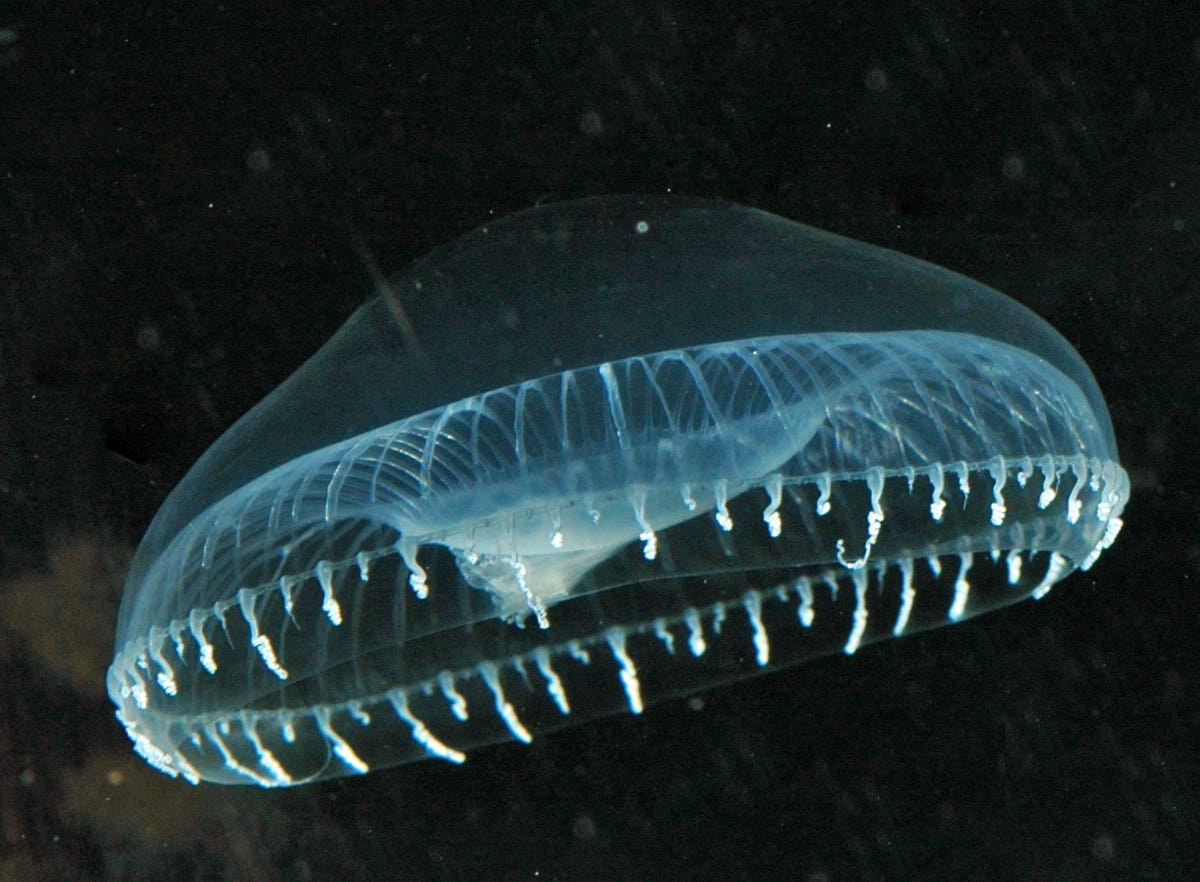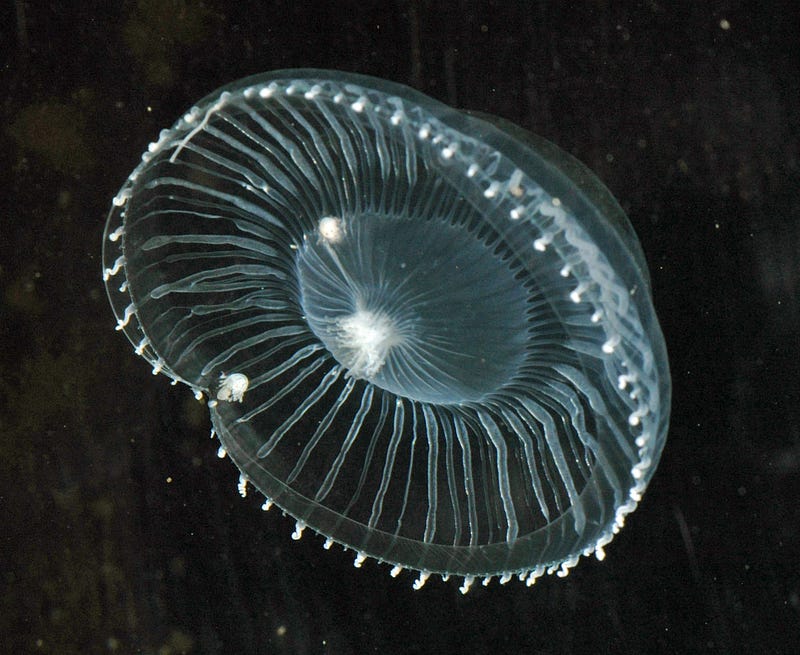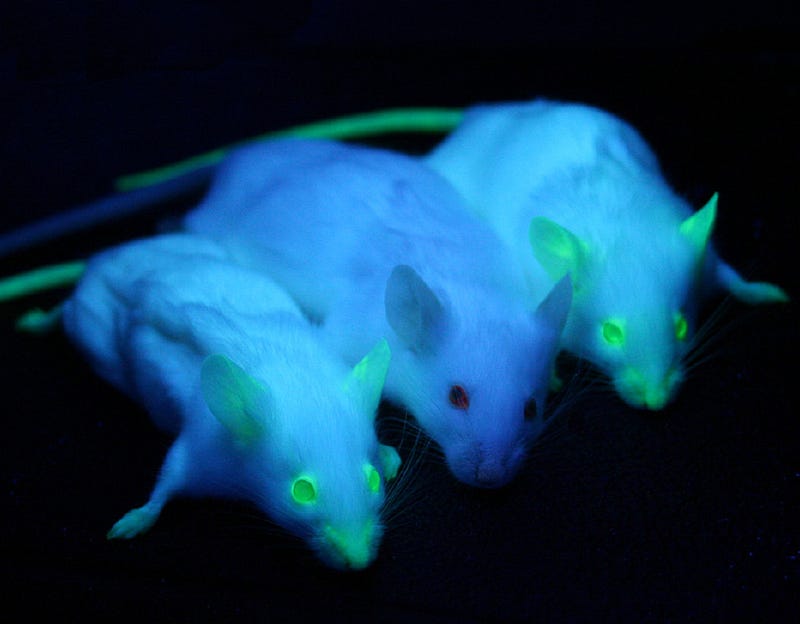
Every bioluminescent organism is slightly unique. Many of the basic features are the same, but the details can diverge over time as new processes and applications arise. Last week, the unique aspect of the bioluminescence was the fact that the glowing material was actually expelled as a secretion. However, as we dive back into the deep marine environment, the uniqueness of the organism this week is even more fundamental and has had important implications for ongoing biological research.
The animal pictured above is Aequorea victoria, the crystal jelly, a small sea jelly native to the North American coast of the Pacific Ocean from the Bering Sea to southern California. Like many of its taxonomic relatives, it exhibits a two-stage life cycle. The form that we most associate with ‘jellyfish’ is called the medusa stage, a free-floating form that lives for only about six months in this particular species. Its main purpose is to produce gametes for sexual reproduction. Fertilized gametes settle on a hard substrate on the bottom and form the hydra stage, a sessile, colonial polyp form (similar in appearance to their relatives the corals and anemones) that asexually buds new medusae every spring.

The medusa of the crystal jelly, and some other members of its genus, exhibit bioluminescence around the rim of its bell in the medusa stage. What makes this particular example interesting is that this species was the first one identified that used a particular set of proteins known as aequorin and green fluorescent protein (GFP). You might recall from my Season 8 introduction that I described the bioluminescent process as a ‘chemical redox reaction’. This involves the transfer of electrons and generally requires the presence of oxygen in order to function. However, Aequorea victoria were observed producing light even in anaerobic environments, leading to initial speculation that it actually stored oxygen for use in this process.
However, once the protein aequorin was described and understood, it became clear that while oxygen was required for certain processes involving the protein and its substrate, the actual light-emitting reaction occurred because of an interaction with calcium ions. Once it became clear that the level of light was related to the levels of calcium, aequorin has since been used as an indicator of calcium ion levels within cells of various organisms undergoing research.
Furthermore, the luminescence in this organism uses a second protein that is fluorescent (emits light when exposed to energy). Aequorin emits blue light and GFP fluoresces bright green when first exposed to blue light wavelengths. Thus, GFP actually color shifts the bioluminescence of Aequorea victoria and some other species in which it can also be found. The discovery and development of this protein merited the 2008 Nobel prize in Chemistry for the scientists who worked on it.
GFP is usually the protein involved when you hear someone talk about a ‘glowing’ genetically modified organism. Do understand that this is not done on some Frankensteinian whim, simply because we can. GFP is usually paired with another trait as a reporter gene, a way to tell if the actual gene being studied has been taken up and expressed by the organism. The presence of a glow from GFP gives an easy visual indication of this. Before its discovery and development, reporter genes with easy visual indicators were often toxic to the cells that expressed them. So far, GFP has proven to have no effect on the cellular environment of the host.

As revolutionary as the bioluminescence from the crystal jelly has been in furthering genetic research, what purpose does it actually serve in its natural environment? Unfortunately, this is still unknown. There is some possibility that the specific color of the glow can shift with depth. This involves the effects of hydrostatic pressure on the chemical processes and thus the overall final wavelength of light emitted by the combination of aequorin and GFP. However, the population of jellyfish in Friday Harbor near Puget Sound, Washington (the location where GFP was originally discovered) have recently collapsed, making further study of the effects of its bioluminescence in the wild difficult (though their overall population is still strong).
Above all, I think this week’s story shows that the natural world is always an exercise in exceptions. Throughout my nature writing, you will find a variety of qualifiers indicating trends and other concepts that do not give the appearance of 100% certainty. Part of this is because science is always refining our understanding of the natural world. While well-established theories are unlikely to be simply toppled and discarded, they can go through major revisions so that they better reflect current data. However, this reticence is also because I understand that there are always unique quirks out there that make something slightly different than the usual. Aequorea victoria possesses a few of those quirks, and their discovery has greatly enriched our ability to push the boundaries of our understanding of genetics and inheritance. In the end, that’s what science is really all about: searching for the quirks.
We’re coming in to the home stretch for Season 8, only four weeks left to go. I hope you continue to enjoy our journey throughout the natural world. As always, I greatly appreciate any feedback on my writing and selection of topics. And if you know someone else who you think might appreciate my stories, please share them.